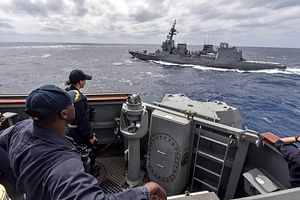The U.S. Navy and the Japan Maritime Self-Defense Force (JMSDF) are holding an annual bilateral naval exercise, codenamed MultiSail 2018, off the U.S.-owned island of Guam in the northwestern Pacific Ocean from March 8-14.
The naval drill will focus on joint anti-submarine warfare and anti-surface warfare operations and will include live fire training. The major aim of the exercise is to improve interoperability between the U.S. and Japanese naval forces.
“MultiSail is an opportunity for our ships to increase our combat proficiency at sea,” said U.S. Navy Captain, Jon Duffy, the commanding officer of Destroyer Squadron 15, a squadron of Arleigh Burke-class guided missile destroyers based in Yokosuka, Japan.
“We have designed MultiSail to exercise how we detect, locate, track and engage simulated units at sea, in the air, on land, and underwater with our Japan Maritime Self-Defense Force allies to help us increase our interoperability in a range of mission areas.”
The U.S. Navy will participate in the exercise with a number of surface warships including Arleigh Burke-class guided missile destroyers USS Curtis Wilbur (DDG 54), USS Benfold (DDG 65) and USS Mustin (DDG 89), as well as the Ticonderoga-class guided missile cruiser USS Antietam.
The JMSDF naval assets include the Akizuki-class destroyer JS Fuyuzuki, a multipurpose warship designed to provide defense against surface, airborne, and underwater threats. It was specifically designed to escort Hyuga-class and Izumo-class helicopter destroyers and their escort ships.
“MultiSail 2018 provide us a valuable opportunity to increase JMSDF tactical capabilities and to strengthen our interoperability with our U.S. Navy allies,” said Commander Kazuteru Hirano, JS Fuyuzuki’s commanding officer. “The Japan-U.S. alliance is stronger than it has ever been, and it is growing stronger.”
Both sides are also likely to dispatch submarines to participate in the drill.
“MultiSail uses realistic, shared training scenarios to enhance the ability of the U.S, Navy and JMSDF to work together to confront any contingency,” a U.S. Navy press statement reads. “MultiSail prepares forces that will provide the deterrence and stabilizing effects of a force-in-being, ready at the outset of a contingency without delays for buildups or extensive mission rehearsal.”
Initially, the MultiSail drill was just a pre-deployment training exercise, but expanded in scope and complexity in subsequent years, where both the U.S. Navy and JMDSD are testing some of the latest equipment, tactics, and procedures.
Last year’s exercise was slightly bigger in size and also included the first-ever U.S.-Japan exchange of goods under the Acquisition and Cross-Servicing Agreements (ACSA), as USNI News reported at the time.

































